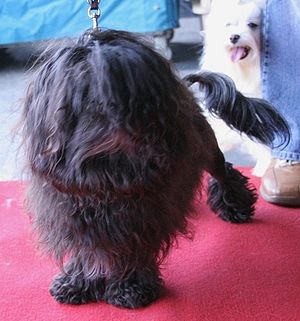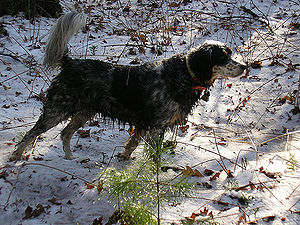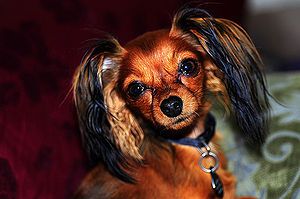 |
| Vital Statistics: |
| Place of Origin: England |
| Group: Sporting dog |
| Height: males 15-17 in., females 14-15 in. |
| Weight: males 28-34 lbs., females 26-32 lbs. |
| Life span: 12-15 yrs. |
| Trainability: moderate |
| Good with children: yes |
| Good with other pets: with the family cat |
What is the origin of the English Cocker Spaniel?
Spaniel type dogs are an old breed, known at least 500 years ago. In the mid 1800s division of Spaniels was based on weight. Spaniels under 25 lbs. were classified Cockers. Larger Spaniels were classified as Springers. These days differences between the Cocker Spaniel and the Springer Spaniel are much greater than weight. The Cocker Spaniel’s name comes from the woodcock, a bird the dog would flush out.
What does the English Cocker Spaniel look like?
The English Cocker is a sturdy, medium sized dog. Males are 15-17 inches tall, females 14-15 inches tall. Weight for males is 28-34 lbs., females, 26-32 lbs. Ears are pendant, long with wavy hair. Eues are dark. The tail is docked where this practice is still legal. The coat is short on the head and back,medium long on the body. The ears, chest and legs are feathered. The coat comes in many colors and combination with solids allowed white only on the chest. Brush the coat regularly. Check the ears often.
What is the temperament of the English Cocker Spaniel?
Although sometimes stubborn the English Cocker is intelligent and responds easily to training with a gentle hand. They usually bond with one family member and are very loyal. They are very good with children and the family cats. With enough socialization, reserved individuals can become more outgoing. These lively dogs need daily leashed walks. With enough exercise they can live comfortably in apartments.
What is the English Cocker Spaniel used for?
They have been used for flushing out and retrieving game. They are good hunters and trackers. The English Cocker also competes in agility and obedience trials. They are good watchdogs as well as good family companions.
Possible Health Issues
Patellar luxation, progressive retinal atrophy, cataracts, kidney disease, hypothyroidism, hip dysplasia, cardiomyopathy, deafness.
- American Cocker Spaniel
- Barbet
- Boulet Griffon
- Boykin Spaniel
- Bull Terrier
- Clumber Spaniel
- Curly-coated Retriever
- Dalmatian
- English Setter
- English Springer Spaniel
- Flat-coated Retriever
- German Shorthaired Pointer
- Golden Retriever
- Gordon Setter
- Harrier
- Irish Setter
- Irish Water Spaniel
- Kishu Inu
- Kooiker Hound (Kooikerhondje)
- Labrador Retriever
- Lagotto Romagnolo
- Landseer
- Mountain Cur
- Nova Scotia Duck Tolling Retriever
- Otterhound
- Picardy Spaniel
- Poodle
- Pudelpointer
- Redbone Coonhound
- Redtick Coonhound
- Rhodesian Ridgeback
- Spinone Italiano
- Stabyhoun
- Sussex Spaniel
- Telomian
- Treeing Tennessee Brindle
- Vizsla
- Weimaraner
- Welsh Springer Spaniel
- Wirehaired Pointing Griffon
- Wirehaired Styrian Mountain Hound
- Wirehaired Vizsla
- Airedale Terrier
- Beagle
- Bedlington Terrier
- Bluetick Coonhound
- Border Collie
- Border Terrier
- Bull Terrier
- Bulldog
- Bullmastiff
- Ca de Bou
- Cavalier King Charles Spaniel
- Clumber Spaniel
- Collie
- Curly-coated Retriever
- Dandie Dinmont Terrier
- English Foxhound
- English Setter
- English Springer Spaniel
- English Toy Terrier
- Flat-coated Retriever
- Golden Retriever
- Greyhound
- Harrier
- Jack Russell Terrier
- Lakeland Terrier
- Lancashire Heeler
- Llewellyn Setter
- Manchester Terrier
- Mastiff
- Norfolk Terrier and Norwich Terrier
- Old English Sheepdog
- Old English Terrier
- Otterhound
- Parson Russell Terrier
- Shetland Sheepdog
- Smooth and Wire-haired Fox Terrier
- Sussex Spaniel
- Welsh Terrier
- Whippet
- Wire Fox Terrier
- Yorkshire Terrier



